With L’Esthétique relationnelle, a literary work by the French critic Nicolas Bourriaud published in ’98, the intuition – which later became philosophical theory – is confirmed, according to which determining the foundations of relational art, is equivalent to using the work as a primary tool for the development of a social context. Bourriaud affirms that in participatory art «The end is not conviviality, but the product of that conviviality, that is, a complex form that unites a formal structure, the objects made available to the visitor, and the ephemeral image born from collective behavior».
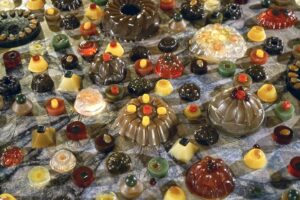
Sonia Andresano, Maria Angeles Vila Tortosa, Carlos Tarrasò, 2023, Dulcis in fundo, installation view at Real Academia de Espana, Roma ph. Luis Do Rosario, courtesy of the artists
Years later even today we can venture that in some urban realities – such as Rome, for example – there is, in the face of a multiple and diversified artistic production in the media used, a certain concentration and a particular attention not so much to the contemplative static and intimate datum in the artwork as to a participatory will on the part of the user. However, even if this observation cannot be the fundemental of every Roman exhibition project, the desire for experience, which sometimes leads to worldliness, risks diverting the viewer’s gaze from the content and ontology of the artwork. Also, the task of criticism is to make a clarification about it, precisely because of the lack of clarity – voluntary or involuntary – towards the user.
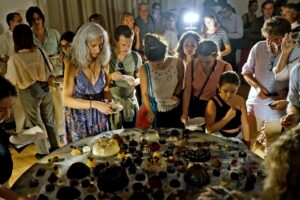
Sonia Andresano, Maria Angeles Vila Tortosa, Carlos Tarrasò, 2023, Dulcis in fundo, installation view at Real Academia de Espana, Roma ph. Luis Do Rosario, courtesy of the artists
The attention that should be paid to Dulcis in fundo, a relational installation by Sonia Andresano, Maria Ángeles Vila Tortosa and Carles Tarrassò, created and opened on September 19, 2023 at the Real Academia de España in Rome, cannot fail to take into account the clear reference to an intrinsic temporality continually recalled and to the constant relationship with otherness. Although Dulcis in fundo presents itself as a performative act where the viewer is invited to respect its sacredness through silence its epiphany translates into a sculptural object born from legacies and traces of a disturbing memory: a «socialization device through which a synesthetic experience is proposed», says Raffaella Perna, historian and art critic, in the critical text.
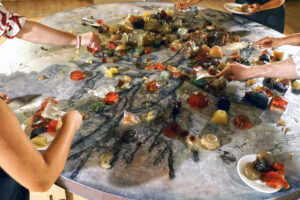
Sonia Andresano, Maria Angeles Vila Tortosa, Carlos Tarrasò, 2023, Dulcis in fundo, installation view at Real Academia de Espana, Roma ph. Luis Do Rosario, courtesy of the artists
Indeed, the unsettling is the continuous relationship of Dulcis in fundo with his double. The intrinsic stability of the table object is lost through the installation by Andresano among raw materials, waste, instead of legs. The artist emphasizes the precariousness that is inherent in the very definition of memory and balance, insisting on the perceptual ambiguity of graceful objects, ivory and glass that, assembled and welded to hooks and industrial pulleys, suggest a strictly bodily fragility, typical of prostheses and human bones. The negation of an absolute translation of the real datum is at the base of the philosophical matrix of thought, where what is visible becomes other, double or not true: the coexistence of opposites or the overturning of their signifiers, on the other hand, is typical of the irony inherent in the artwork, in its continuous play between reality and representation. The iron engraving plane, instrumental matrix of the paper works by Maria Ángeles, becomes the support of a further autopoietic work: traces and signs of organic works crown the design of an engraved natural root. The symbolic allegory of Vila Tortosa’s Botanica Domestica series (2020 – 2022) alludes through organic matter to the potential and cyclic act of its creative and destructive nature, recalling those ancient female archetypes that determined the birth of cultural realities and otherness.
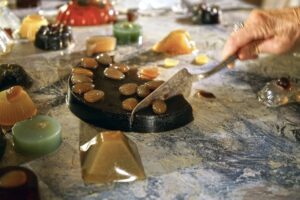
Sonia Andresano, Maria Angeles Vila Tortosa, Carlos Tarrasò, 2023, Dulcis in fundo, installation view at Real Academia de Espana, Roma ph. Luis Do Rosario, courtesy of the artists
It is through the original function of the table that man’s propensity towards traditional rituals is manifested. The ritual carries behind it a sharing of intentions sometimes generating a participatory choral act, the same that in turn determines an act of political power. And it is precisely through the symbolic value of food that Carlos Tarrasò eludes the boundary between private and public space. A table full of sweets, in fact, recalls traces of rituals and domestic experiences that belong to an intimate and private sphere. There is in the spectator, at the time of tasting, an almost devotional attitude that gives shape to a silent suspension followed sometimes by an almost compulsive verbiage and hoarding of food. Tarrasò emphasizes the strong contrast that exists between the imaginary of visual perception and the actual materiality of the work.
Giulia Pontoriero
Info:
Sonia Andresano, Maria Angeles Vila Tortosa e Carlos Tarrasò. Dulcis in fundo
text by Raffaella Perna
19 – 29 September 2023
Real Academia de España – Piazza di S. Pietro in Montorio, 3, 00153 Roma RM
Info: https://www.accademiaspagna.org/dulcis-in-fundo-performance/
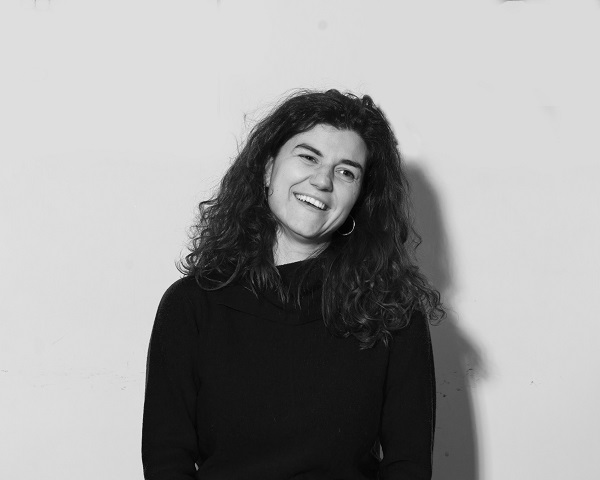
Graduated in Architectural Sciences at the Sapienza University in Rome, with a master’s degree in Contemporary Art and Management at the Luiss Business School, she currently works as an intern and project manager at Untitled Association. Graduated in Photography and Art Criticism in Bologna, she currently carries on her personal projects and is part of the team of the Forme Uniche cultural project.






NO COMMENT